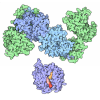Entry Database : PDB / ID : 4jegTitle Crystal Structure of Monobody CS1/SHP2 C-SH2 Domain Complex Monobody CS1 Tyrosine-protein phosphatase non-receptor type 11 Keywords / / / / / / Function / homology Function Domain/homology Component
/ / / / / / / / / / / / / / / / / / / / / / / / / / / / / / / / / / / / / / / / / / / / / / / / / / / / / / / / / / / / / / / / / / / / / / / / / / / / / / / / / / / / / / / / / / / / / / / / / / / / / / / / / / / / / / / / / / / / / / / / / / / / / / / / / / / / / / / / / / / / / / / / / / / / / / / / / / / / / / / / / Biological species Homo sapiens (human)Method / / / / Resolution : 2.3 Å Authors Sha, F. / Koide, S. Journal : Proc.Natl.Acad.Sci.USA / Year : 2013Title : Dissection of the BCR-ABL signaling network using highly specific monobody inhibitors to the SHP2 SH2 domains.Authors : Sha, F. / Gencer, E.B. / Georgeon, S. / Koide, A. / Yasui, N. / Koide, S. / Hantschel, O. History Deposition Feb 26, 2013 Deposition site / Processing site Revision 1.0 Aug 28, 2013 Provider / Type Revision 1.1 Sep 11, 2013 Group Revision 1.2 Sep 25, 2013 Group Revision 1.3 Nov 20, 2013 Group Revision 1.4 Mar 12, 2014 Group Revision 1.5 Oct 30, 2024 Group / Database references / Structure summaryCategory chem_comp_atom / chem_comp_bond ... chem_comp_atom / chem_comp_bond / database_2 / pdbx_entry_details / pdbx_modification_feature / struct_ref_seq_dif Item / _database_2.pdbx_database_accession / _struct_ref_seq_dif.details
Show all Show less
 Open data
Open data Basic information
Basic information Components
Components Keywords
Keywords Function and homology information
Function and homology information Homo sapiens (human)
Homo sapiens (human) X-RAY DIFFRACTION /
X-RAY DIFFRACTION /  SYNCHROTRON /
SYNCHROTRON /  MOLECULAR REPLACEMENT /
MOLECULAR REPLACEMENT /  molecular replacement / Resolution: 2.3 Å
molecular replacement / Resolution: 2.3 Å  Authors
Authors Citation
Citation Journal: Proc.Natl.Acad.Sci.USA / Year: 2013
Journal: Proc.Natl.Acad.Sci.USA / Year: 2013 Structure visualization
Structure visualization Molmil
Molmil Jmol/JSmol
Jmol/JSmol Downloads & links
Downloads & links Download
Download 4jeg.cif.gz
4jeg.cif.gz PDBx/mmCIF format
PDBx/mmCIF format pdb4jeg.ent.gz
pdb4jeg.ent.gz PDB format
PDB format 4jeg.json.gz
4jeg.json.gz PDBx/mmJSON format
PDBx/mmJSON format Other downloads
Other downloads 4jeg_validation.pdf.gz
4jeg_validation.pdf.gz wwPDB validaton report
wwPDB validaton report 4jeg_full_validation.pdf.gz
4jeg_full_validation.pdf.gz 4jeg_validation.xml.gz
4jeg_validation.xml.gz 4jeg_validation.cif.gz
4jeg_validation.cif.gz https://data.pdbj.org/pub/pdb/validation_reports/je/4jeg
https://data.pdbj.org/pub/pdb/validation_reports/je/4jeg ftp://data.pdbj.org/pub/pdb/validation_reports/je/4jeg
ftp://data.pdbj.org/pub/pdb/validation_reports/je/4jeg Links
Links Assembly
Assembly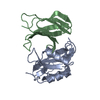
 Components
Components Homo sapiens (human) / Gene: PTP2C, PTPN11, SHPTP2 / Plasmid: pHBT / Production host:
Homo sapiens (human) / Gene: PTP2C, PTPN11, SHPTP2 / Plasmid: pHBT / Production host: 
 Homo sapiens (human) / Plasmid: pHFT2 / Production host:
Homo sapiens (human) / Plasmid: pHFT2 / Production host: 
 X-RAY DIFFRACTION / Number of used crystals: 1
X-RAY DIFFRACTION / Number of used crystals: 1  Sample preparation
Sample preparation SYNCHROTRON / Site:
SYNCHROTRON / Site:  APS
APS  / Beamline: 24-ID-E / Wavelength: 0.97918 Å
/ Beamline: 24-ID-E / Wavelength: 0.97918 Å molecular replacement
molecular replacement Processing
Processing MOLECULAR REPLACEMENT / Resolution: 2.3→19.347 Å / Occupancy max: 1 / Occupancy min: 1 / FOM work R set: 0.8461 / SU ML: 0.26 / σ(F): 1.44 / Phase error: 22.11 / Stereochemistry target values: ML
MOLECULAR REPLACEMENT / Resolution: 2.3→19.347 Å / Occupancy max: 1 / Occupancy min: 1 / FOM work R set: 0.8461 / SU ML: 0.26 / σ(F): 1.44 / Phase error: 22.11 / Stereochemistry target values: ML Movie
Movie Controller
Controller



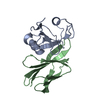

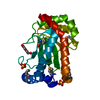
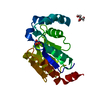
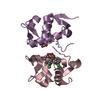
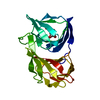
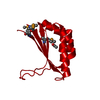
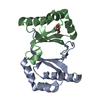


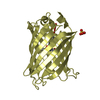
 PDBj
PDBj














